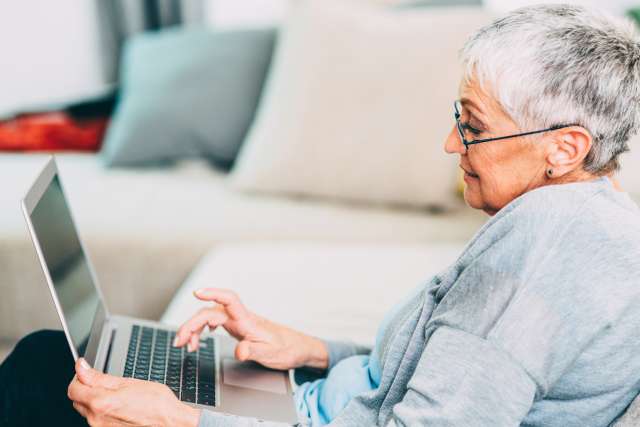In March 2015, the Los Angeles County Department of Health Services (LAC DHS), one of the largest safety net health systems in the country, rolled out a patient portal for its four county hospitals and 19 public health centers. It allowed patients to check past doctor visits, lab results from tests and upcoming appointments.
But two years after the “MyWellness” rollout, , partnered with LAC DHS operational leaders, were trying to find out why less than 15% of patients were registered on the site.
One woman recounted her experience in the study: Her son heard about the app from his hair stylist, who encouraged him to download it on his mother’s phone. But he was not able to do it. So the woman decided to ask the stylist directly.
“I came to the beauty salon and I said to my daughter, ‘Look, there’s the lady,’” recalled the woman, speaking in Spanish. “And another lady who passed by said, ‘Ask her how to get the program with all your doctors’ appointments and information.’”
With the “MyWellness” app finally on her phone, the woman got access to the patient portal.
The event was an incremental step in narrowing the digital divide – unequal access to technology. These days, lack of access to technology and technology education can mean lack of health care.
“We are expecting people to use health care technology to access basic services, like making appointments or contacting their provider,” said Alejandra Casillas, MD, MSHS, an associate professor of medicine in residence in the division of general internal medicine and health services research at the . “And that really leaves people out.”
Currently, there is no standardized method to determine who is being left out. A collaborative of researchers at UCLA, UCSF and Harvard is at the forefront of working toward best practices for a screening tool to assess digital health access.
Dr. Casillas was senior author of the group’s findings, which were in July in the journal Frontiers in Public Health.
“This paper is a call to action,” she said. “We need to develop more evidence-based standards as to how we assess people's needs so we can better serve them.”
The collaborative hopes that a screening tool will better align digital health equity with other social determinants of health, such as food security, housing and employment. Screening tools are already available to assess several socioeconomic needs.
“The importance of digital equity extends beyond the clinic as well,” said Ann Marie Hernandez, MD, MPH, first author of the study and an assistant professor in the department of family medicine at the David Geffen School of Medicine at UCLA. “Digital literacy and access are becoming increasingly necessary for everyday life. Everything from apartment hunting, online banking, job searches, and educational opportunities require the use of technology. All of these factors impact an individual's health and well-being.”
Digital exclusion
The people most affected by social determinants of health and the people who have less access to technology may overlap.
For example, 80% of U.S. adults overall have a home broadband internet subscription, according to a January 2024 from the Pew Research Center. But it falls to 65% for those with a high school diploma or less, and 57% for people with a household income less than $30,000.
The research collaborative stressed that Internet access is not the only marker of the digital divide. Digital literacy – the skills and understanding of how to access information – is also key, as is having the appropriate devices to access technology. Though 90% of Americans have smartphones, 15% of U.S. adults on them exclusively for access to the internet. Not all health tech platforms, including patient portals, are accessible on a handheld device. In addition, they are mostly English language only.
“When we try to characterize the digital divide, the health care disparities that affect underserved, low-income, linguistically diverse populations, trickle down to the technology side,” said Dr. Casillas. “Rural areas are affected as well. Another big population that is often forgotten about are unhoused people.”
Already, the UCLA researchers’ work has driven innovation. In partnership with leaders at LAC DHS, they have created the program, where a community health worker is onsite, informing patients about the patient portal (the same one the woman learned about at the hair salon, now renamed “LA Health Portal”) and the ability to make video visits.
That portal is also one of the few bilingual English-Spanish interfaces. And recently, the portal’s smartphone version was beefed up to the level of the desktop version when administrators realized most patients were accessing on their phones.
“Over the last three years, our health tech navigators have increased enrollment from about 15% to over 50%, and tripled the number of Spanish-speaking patients enrolled,” said , director of patient engagement at LAC DHS and an assistant professor of medicine at the David Geffen School of Medicine at UCLA. “This program has transformed our patient’s digital health literacy and promotes true digital health equity.”
What’s next: a screening tool
With their findings, the collaborative is laying the groundwork so researchers, health systems leaders, patient advocates and community stakeholders can devise concise, empathetic digital health access screeners.
At the heart of a successful survey are questions with patient-centered, patient-friendly language. For example, patient perspectives included in the study revealed that referencing cost of Internet and inability to pay in a question felt insensitive. Patients preferred a question about “affordable Internet.”
“The framing of these questions is important, so people feel like we're not judging them … because they're not using the Internet,” said Dr. Casillas. “It's just letting them know we understand that … it's not a reflection on the patients. It's a reflection of the systems that the patients live in and their environment.”
Developing questionnaires is just the first step. Ensuring validity in different languages and looping back to real data will be a lengthy process, Dr. Casillas said.
And even after health systems create surveys, “screening for the sake of screening” is not adequate, she cautioned. Administrators must follow up with resources and recommendations to improve technology access.
Overall, interest in digital equity is expanding. An online meeting organized by the collaborative in April drew almost 200 people.
“I’m hopeful because I see momentum and movement on the policy level, statewide and nationally, to treat digital health like any health care service with certain standards and metrics,” said Dr. Casillas.
“Let's center the marginalized because that will ensure we all move forward together, and that all our patients are best served.”





